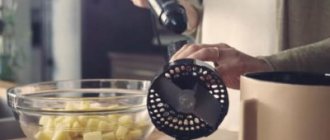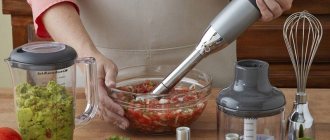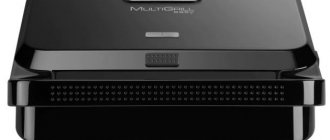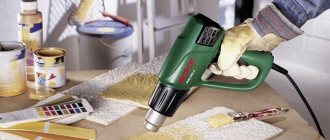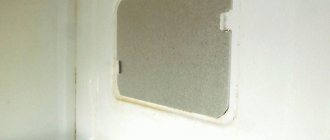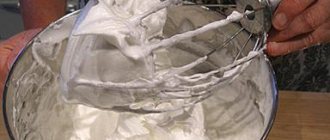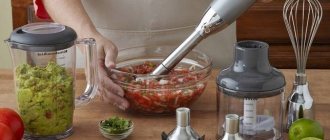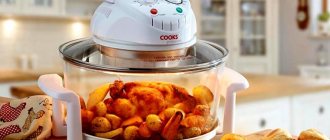What is a blender and who invented it?
The word blender comes from the English blender - to mix. This unit is one of the oldest kitchen units. Only the meat grinder is older than him (25 years).
The first such device was invented by Stephen Poplawski in 1922. The idea for this device came to him in an attempt to automate the preparation of the soda fountain drink. In the USSR, such a drink was known as “soda with syrup,” which was sold everywhere in special vending machines.
The first of these units consisted of a container on a stand. At the bottom of the bowl there was a knife similar to a propeller, which could only mix the ingredients, but not cut. In fact, this was the first prototype of a stationary blender.
It became widespread during Prohibition in the United States due to the fact that establishments began to secretly serve alcohol only in cocktails (to avoid police claims). The blender at that time allowed bartenders to automate the preparation of drinks and meet the increased demand.
A modern blender can easily replace a food processor. Its main advantage is that it is quite small-sized and easy to handle, which allows it to be used without any extra effort. With this unit you can easily chop, cut and beat ingredients for dishes.
About
Reasons for the popularity of this technique
- Using a blender, you can easily make fruit or vegetable purees. It is for this reason that this device is so popular among young mothers.
- Effectively processes both small and large portions of food.
- The blender's functions allow you to quickly and easily grind nuts for pate or cake.
- In a few seconds it will mix the ingredients of a protein or energy shake.
- Helps prepare non-alcoholic and alcoholic drinks for the upcoming party.
- He will make minced meat and then mix the ingredients for delicious cutlets.
- It does an excellent job of chopping berries and herbs and whipping up aromatic smoothies.
- Makes puree for making soup. In addition, it can be served as a separate dish.
- Mix the ingredients of salad dressing or sauce.
- It will help in preparing salty or sweet fillings, make a paste from cottage cheese and grate breading or chocolate chips.
The blender also has many other possibilities . Among other things, this kitchen appliance is very easy to care for - the knives and bowl can be washed quickly and easily, as well as the nozzles with the measuring container.
It is not advisable to wash only the handle or the motor with the stand. It is recommended to wipe these elements with a damp cloth or wipes from time to time.
Regardless of the manufacturer, type and other characteristics, equipment should be cleaned after each use.
In addition, before processing food, you should make sure that it has cooled to at least 80-82 degrees. High temperatures can cause plastic parts to deform.
Despite the wide selection of attachments and not very rich functionality, using the blender is very convenient and simple . Of course, you don’t have to use mixers, meat grinders, microwaves, blenders and other devices. However, with them it’s more pleasant, more convenient, and faster.
Types of devices and their differences
Existing types of blenders:
- submersible;
- stationary.
A stationary blender is a device that consists of a technical unit and a mixing glass with knives at the bottom.
The advantage of this type of device is that, unlike an immersion blender, you do not need to constantly hold the device in your hands to grind food.
The disadvantage of a stationary blender is that you can only mix the ingredients in the bowl supplied. But it is great for making various cocktails and smoothies.
An immersion blender differs from a stationary blender in having wider functionality. The device consists of two parts: a hardware unit and an attachment, while the number and functionality of attachments may vary.
Pros of an immersion blender:
- You can grind products in any container that is resistant to mechanical stress, which allows you to work with any volume of ingredients
- A large number of attachments that expand functionality (whisk, chopper, etc.)
- It doesn't take up much space in the kitchen
Flaws:
- You must always hold the device in your hands
- Not suitable for preparing liquid foods
Blender bowls and containers can be made of plastic, glass and metal. At the same time, glass, if handled carefully, is the most durable and environmentally friendly. Nozzles are made of stainless steel or plastic.
Professional blenders are a special type of device. They have large bowl capacity, power and high reliability, but their price is much higher. Also, as you can already understand from the name, such devices can be not only for home use, but also for commercial use.
As a result, the difference between devices for grinding products lies in their different purposes. The stationary one is better at mixing and whipping liquid mixtures, and the submersible one is better at slicing and grinding harder products.
About
Purpose on the farm
Some housewives believe that if you have a food processor, a blender is completely unnecessary, but this is not true. Although these devices have similar functions, they have many differences .
- The blender combines the capabilities of a mixer, a food processor, and a “masher” for making purees.
- The device has compact dimensions, making it more mobile.
- Assembling promptly.
- Thanks to the presence of knives, there is no need for many attachments.
- Allows you to quickly process products.
Therefore, taking into account the design and dimensions of the blender, this technique can:
- puree various foods;
- grind fruits, vegetables and meat;
- grind nuts, coffee beans and ice;
- mix ingredients for cocktails, mayonnaise, sauces and dressings.
In order to make puree from fruits and vegetables, you must first cut them into pieces and add a small amount of water. This way the device will cope with its task more efficiently. In addition, such preparation will avoid burnout of the device.
Types of blenders
Today there are two types of such technology:
Immersion blenders are designed in the form of a handle that allows you to install various attachments. The most popular option is a chopper with built-in knives.
When asked what an immersion blender is for, you can answer that such a device is great for vegetables and fruits, making sauces and purees. And the use of a special whisk attachment allows you to make dough for pancakes or an omelet.
Expert opinion
Mikhailova Maria Vasilievna
Furniture store manager. Knows everything about comfort and interior design
If you have to prepare cream soups and purees in large quantities, it is recommended to select a model with a metal nozzle. This will make it possible not to worry about the temperature of the processed product.
Often, a blender comes with a measuring container where products for processing are placed. If the set includes a sealed bowl and powerful knives, then with this blender you can easily grind ice, vegetables, fruits, nuts and meat.
Another type of blender is stationary . It is a jug with a stand and a motor. It copes well with crushing ice cubes, crushing food and other tasks. If you choose a fairly powerful device, it will also cope with preparing dough.
One of the main advantages of stationary models is that there is no need to hold them suspended, that is, your hands will not get tired when working with them. As for the functionality, it is similar to the options that an immersion blender has.
Useful features of blenders
Here are the most popular blender functions:
- Mixing - one of the most popular functions allows you to mix and simultaneously beat liquids and suspensions until smooth. This function is basic for stationary devices.
- Shredding and slicing - allows you to grind food to the required consistency. In some models, the duration and intensity of cutting can be controlled manually, which allows you to achieve the optimal consistency of products for each dish, from slicing to purees.
- Whipping - many hand blenders have this mode thanks to the whisk attachment. In some cases, it allows you to replace the mixer, but it is still inferior in power.
Additional features and capabilities:
- Ice crushing.
- Preparing mixtures in a vacuum environment (allows you to keep cocktails fresh longer).
- Speed adjustment and turbo mode (allows you to control the speed and intensity of the device).
- Grate food directly into the cooking bowl thanks to the grater attachment.
- Expensive models have the function of kneading dough using special hook attachments. Thanks to them, the dough is kneaded evenly and does not stick to the walls of the bowl.
About
Practical kitchen blender device
A blender is a compact, modern, practical kitchen device designed to replace many hand-held household appliances and significantly make the “life” of housewives in the kitchen easier. Thanks to this device, you can very easily chop nuts, mix ingredients for mayonnaise or form an original cocktail, make minced meat, etc.
The main function of a blender is the ability to grind food, but its mechanism allows you to quickly split ice using this household appliance, and there are models that can even cut food into cubes for salad. This kitchen unit has all the necessary functions, making it a successful competitor to the “practical” but very bulky food processor.
What can you cook in a blender?
Using a blender you can prepare a huge number of dishes:
- puree soups;
- cocktails;
- sauces;
- salads;
- various desserts.
Here are some of the most popular dishes and the general principle of preparing puree soups.
The principle of preparing puree soups using the example of cream of mushroom soup
To prepare mushroom cream soup from champignons, you need:
- 500 grams of potatoes of any size.
- 150 grams of onion.
- 600 grams of water.
- 250 grams of mushrooms (fresh or frozen).
- 200 grams of cream 10-20% fat.
- salt (at your discretion).
First, finely chop the onion into cubes and fry in refined vegetable oil for 5 minutes at medium temperature until golden brown.
Mushrooms are cut into medium pieces (you can cut several pieces lengthwise “in the shape of a mushroom” for decoration). Chopped champignons are added to the fried onions and fried together for 7-10 minutes to enhance the taste and aroma.
Next, place a pan of water on the stove and prepare the potatoes (peeled and cut into the size of a walnut). After boiling, the potatoes are thrown into the water and cooked until tender for about 15 minutes.
Then add the onion-mushroom mixture to the pan and cook for another 5 minutes, and then grind the pieces of vegetables in the soup with a blender until pureed.
The last step is to add cream to the prepared mixture and bring to a boil, stirring. The dish is decorated with pieces of fried mushrooms and herbs.
The general principle for preparing all such soups is to grind the solid ingredients to a homogeneous puree-like mass, and the base of the soup can be anything: vegetable, as in the presented recipe, or broth.
Curd
The recipe for making curd mass is extremely simple.
To make the curd mass, you need:
- about 500 grams of cottage cheese
- 4-5 large spoons of sour cream
- salt and sugar to taste
Proportions are approximate and may vary. Also, if desired, you can add various berries and jam.
An immersion blender works best for preparing this dish. All ingredients are loaded into a bowl and ground until smooth within 2-3 minutes.
Milkshake
A stationary blender will handle a milkshake better.
The principle of its preparation is to whip milk and ice cream with various fillings. Moreover, the ratio of ingredients can be very different depending on preferences. For example, for a classic milkshake, a glass of milk and a couple of scoops of creamy ice cream will be enough.
Of course, this is not everything that can be prepared using a blender; there are hundreds of recipes using this device.
About
Benefits and Features
Most housewives compare blenders with food processors, so they believe that they do not need the first option. However, despite the similarity of the devices, they have numerous differences.
Blender advantages:
- This device contains options not only from a food processor, but also from a mixer, along with a manual “masser” for creating purees;
- the unit has small dimensions, which indicates its mobility;
- quick assembly;
- since the device has knives, you will not need numerous attachments;
- high performance.
What a blender can do:
- finely chop vegetables, fruits, meat in any form (except frozen);
- make puree from products;
- mix ingredients to create sauce, mayonnaise, cocktail.
To puree tough foods, you will need to first cut them into small pieces and add a small amount of water. With this manipulation, the device will easily turn the products into a puree state.
If you have acquired a submersible model, you can use it to chop different types of vegetables and fruits in any container. This blender is small in size, has many options, and can turn any food into puree in a short time.
Such a device will be indispensable if you regularly make puree soup, smoothies or various sauces.
What can you grind in a blender?
You can grind many ingredients in a blender.
The most popular of them are:
- Vegetables, fruits and berries - cucumbers, tomatoes, carrots, cabbage, eggplants, zucchini, onions, pumpkin, apples, bananas, pears, etc. Almost any berries can be chopped. It is important to mention that when mashing boiled potatoes with a blender, it becomes more viscous and dense due to starch and this consistency will not be to everyone’s taste. You should also refrain from blending apples with metal attachments, since when it comes into contact with metal, the apple oxidizes and changes its taste.
- Various greens - parsley, dill, green onions.
- Nuts - peanuts, walnuts, cashews, almonds and others. At the same time, they can be ground into a paste.
- Meat - beef, pork, veal, lamb. The resulting minced meat has a slightly different, denser consistency, which makes the cooked meat more uniform, but less juicy.
- The blender can also be used as a coffee grinder - grind coffee and crush ice if you have a special grinder.
For better processing, it is recommended to pre-cut all products into pieces, and boil especially hard ones.
About
Characteristics of equipment
When considering the parameters of the equipment, it is important to decide what blender you need in your kitchen, and only then make a choice:
- power;
- number of speeds;
- volume and material of the bowl;
- cleaning and care;
- nozzles;
- nutrition;
- price.
Power. With the help of high-power models, you can make any dish without much difficulty chopping raw vegetables, beating eggs, or preparing a milkshake containing crushed ice. The low-power type will do an excellent job with the above tasks; it is suitable for mixing boiled vegetables, fruits and creating cocktails.
Today, the number of speeds on the unit varies from 2 to 5, which makes the operation of the device controlled by the owner of the blender. The kitchen appliance can also be equipped with a turbo mode, which increases the operating speed to the maximum possible speed for a short time.
The bowl material can be either plastic or glass. Obviously, glass containers are more durable, they do not get scratched when grinding hard products, such as cereals, nuts, coffee, do not absorb odors, and do not stain.
But at the same time, glass makes the blender more vulnerable; if you drop it, the bowl may break. A plastic container loses its transparency over time.
Care. Many stationary models, as noted above, are equipped with a self-cleaning system, which allows you to wash the unit quickly and efficiently, and the likelihood of cutting yourself on the knives is minimized.
Nozzles Today, numerous modern models are equipped with additional attachments, such as whisks for beating eggs and dough, a measuring cup with knives for chopping, and an attachment for crushing ice, with the help of which the functions of the blender are expanded to the functionality of a food processor.
Price. Stationary blenders are inferior in functionality to immersion blenders, so the cost of the latter is slightly higher. This is understandable, since the device comes with more attachments and containers.
The most important rules of use
Basic Rules:
- It is forbidden to wash the base handles and motor stands under running water or immerse them in it in any way, as the liquid will damage the electronic components. To clean these parts, use a well-wrung damp cloth or a special cleaning cloth.
- If a burning smell appears during operation, turn off the device immediately.
- Do not use a faulty device; if it breaks down, take it to a qualified technician at a service center.
- The use of the blender by children and persons who do not have the skills to safely handle the device is prohibited.
- When operating the blender, do not put your fingers into the container with the device running, and also be careful when washing, as the knives are very sharp.
These operating instructions for the device should be treated with extreme caution, as failure to comply may result in injury and damage to the device.
About
Precautionary measures
When using any household appliances, and a blender in particular, you must be extremely careful and carefully follow all operating instructions, since there is a possibility of injury and other damage. This is especially important for those devices that constantly interact with food. And in a blender it can be wet and sometimes greasy. To ensure that the blender brings only benefits and does not harm you, manufacturers have specially drawn up rules for its proper use. They must be included with the device. But if you have lost them or you don’t want to plunge into the world of boring technical language, then we will tell you everything here.
If you have an immersion blender, then under no circumstances immerse it in food more than halfway up the stem. Be careful that splashes or pieces of processed food do not get into the unit’s motor.
Be sure to unplug the device from the outlet as soon as you finish using it. Remove the nozzle and rinse under running water. You can wash the immersion blender and, in particular, the attachment, using a mild detergent. Then dry each part thoroughly.
Never connect wet parts to the handle of the device. This way you will permanently damage the device.
If you need to clean the handle where the motor is located, do it with a damp cloth. Just gently wipe the part with it. And make sure that moisture does not get on the motor. Otherwise, your device will stop working and you will just have to throw it away.
And a little childish advice: do not stick your fingers in to remove a stuck piece from under the knife while the device is on.
If you have a stationary model, to wash it, pour cool water into the bowl and start the device. In a few seconds everything will be cleaned, and you just need to pour out the dirty water. After this, the bowl should be rinsed a little more and dried completely.
Do not wash the stand under any circumstances; this is dangerous for you and your device. All you can do if it gets dirty is gently wipe it with a damp cloth. But before doing this, be sure to unplug the device from the outlet.
Use the device according to the power it is capable of. That is, don't try to squeeze more out of it, you'll just overload it. Be sure to let him rest and cool down. This is especially true when you are grinding hard products. Some models are equipped with a special auto-shutdown, which is triggered if the unit overheats.
Despite the fact that a blender is a chopper, put only chopped products into it, remove seeds and stalks from them.
Do not try to chop greens with a stationary unit. It's just not designed for this type of work. These devices must be loaded at least halfway so that they function normally and are not overloaded.
Pay attention to what material the body is made of. If it is plastic, then be very careful with it. Excessive load and falls can ruin it. But if the body is metal, then it cannot be cleaned with powder and hard sponges. Otherwise, scratches will appear.
General step-by-step instructions
Instructions on how to properly use a stationary blender:
- Connect the block rack with the motor to the electrical network
- Place food in the mixing bowl without exceeding the maximum mark.
- Attach the filled bowl to the motor unit and be sure to cover it with a lid.
- Turn on the device using the required mode, following the time recommended for continuous operation (it varies for devices from different manufacturers, usually 2-3 minutes)
- After mixing, pour the resulting mixture into a container, and carefully wash the bowl and wipe dry
- Unplug the device from the outlet after use.
Instructions for the immersion blender:
- Attach the required attachment to the blender
- Connect the handle-base with the motor to the electrical network
- Place food in a scratch-resistant container
- Turn on the device using the required mode, following the time recommended for continuous operation (it varies for devices from different manufacturers, usually 2-3 minutes)
- When you are finished mixing or grinding, unplug the appliance.
- Detach the nozzle from the base handle for later washing
If you follow the correct operating mode, your blender will remain an indispensable assistant in the kitchen for a long time and will serve for many years.
About
Recommendations for purchasing a device
When choosing a device, it is important not only to know what a blender of a particular modification is intended for, but also to pay attention to the details. The following can play a role in making a decision in favor of a particular model :
- Power. This value determines what can be ground in a blender. The device can easily process soft food with a power rating of up to 500 W. For solid ingredients, a more powerful model will be required.
- Speed. Affects the processing time of products. Smoothly adjustable with a rotary knob or a choice of fixed levels. Simplified models do not have a speed controller.
- Possibility of battery operation. Such devices are low-power and heavy. It is advisable to use them outside the home or when the work area in the kitchen is far from the outlet. Needs to be charged regularly.
- Availability of additional functions. If you plan to use the device for any other purposes besides shredding, carefully study the attachments included with the device.
- Material and volume of the bowl. Bowls usually have a capacity of up to 2 liters. The set may include additional containers smaller than the main one. They are made from glass or plastic. Glass ones are resistant to high temperatures, but more fragile. Plastic gets scratched over time.
- Material of the immersion part. Metal is more durable and heat-resistant than plastic, but heavier. Plastic devices are slightly inferior to metal ones. They are lighter, but over time they can change color under the influence of coloring agents in products.
- Appearance of the case. The body is also made of metal or plastic. When choosing, it is worth noting whether the body of the device is equipped with rubberized inserts or anti-slip feet, and whether the button on the submersible model is conveniently located.
- Noise produced. Powerful devices are noisier.
Assess your needs before purchasing a blender . Analyze the frequency and volume of food preparation, the range of products that you usually use. The composition of the family is important - the number of people, their age, preferences.
Where should I put the food?
A bowl or jug is used as a working container for a stationary blender. The choice of this component affects the quantity and quality of the products that are ground.
Glass bowls are considered the best. This is due to their performance characteristics. Their main advantages:
- Virtually scratch-resistant.
- Do not fade after a long period of use.
- Works great with hot dishes.
The only drawback is considered to be fragility.
The volume of the bowl is called the main secondary parameter. You also need to focus on it when choosing. The small volume of the bowl will not allow you to cook a lot of food at once.
When choosing a work container, you should think: “How much food will I cook at one time?” If the blender will be used exclusively for liquids (cocktails or smoothies), then taking a bowl with a volume of more than 500 ml is not cost-effective. However, for preparing pureed soup for a family of several people, there is no point in even looking at small bowls. The only option is a container of 1.5 liters.
Important! If you fill the working container to the brim, the contents will spill out of it when the blender operates. The permissible filling is 80% of the maximum bowl volume.
Most of the bowls are made in the shape of a jug. There are two factors to consider when choosing a jug:
- Wide base. A pyramid-shaped container is easier to clean from food debris.
- Presence of a spout. Makes life easier for the housewife, making it easier to pour the contents of the bowl into the dishes.
Each bowl has a marking indicating the maximum capacity. The closing lid can be with an opening cork to add food during cooking, or monolithic.
Occasionally, there is a drain tap at the base of the bowl. Will help for pouring liquids without separating the work surface from the block.
Slightly non-standard shapes are also available for purchase - for example, a chopper glass. This model is perfect for athletic people who make cocktails every day and use a small blender. The chopper allows you to quickly pour prepared liquids into a glass without separating the working container from the base of the blender. A useful property for those who do not want to waste time pouring their favorite cocktail. You just need to take a chopper cup with you.
Some models have a self-cleaning function. To do this, just pour warm water and activate this option. The mode will clean the blender on its own, after which you just need to pour out the water.
Reminder! For many, a nice bonus when buying a blender is a glass mill for coffee beans. If, when purchasing top-end products from a world-famous manufacturer, the seller offers to purchase this device, then you should know that it is a fake. Such a glass is simply not provided for additional components of branded items.
Smoothie recipes for weight loss for Blender
This drink option is suitable for those who care about their figure and want to maintain an attractive shape or lose a little weight for the summer season.
A smoothie is a drink with different flavors, so you can add any ingredients to it.
Ingredients:
- low-fat kefir - 1 tbsp.;
- green apple (Simirenko variety is suitable) - 1 pc.;
- kiwi - 1 pc.
Method of preparation: pour kefir into a blender container, peel the kiwi, cut into half circles and immerse in kefir. Wash the apple and remove the seeds, cut it into several parts and put it in a blender. You can also add chopped fresh parsley to the mixture. Start the blender at first speed and gradually increase it. Preparation time is 5-10 minutes, depending on what consistency you want the drink to be.
Blender Care
Since the blender is an electric device, its individual parts cannot be immersed in water or washed in the dishwasher. This applies primarily to the motor unit, which is plugged into the socket, the whisk attachment adapter, and gearbox covers. They can only be wiped with a damp sponge and dried with a towel.
Removable blender parts that do not contain moving elements inside can be placed in the dishwasher
It is better to wash bowls, removable knives, and whisk under warm running water using regular dishwashing detergents. All washed parts must be dried and put back in place so that it is convenient to store the blender in assembled form, which is always at hand and ready for use.
If you want to see how to choose and use a blender correctly, we offer you the following video:
Types of devices
All blenders sold today can be divided into two large groups: submersible and stationary. Some classify so-called multi-sets in a separate group, which are in fact a type of immersion blenders.
Each of these types of blenders has its own purpose, but they all have the same essence. It is with their help that you can reduce the time for chopping and mixing products, whipping them and even crushing ice. Therefore, before making a purchase and making a choice in favor of a specific blender, it is necessary to study in detail for which cooking operations this or that model is best suited.
Advantages and disadvantages
Due to its design, an immersion blender has both advantages and disadvantages.
Pros:
- It is small in size, so the device can be stored in any kitchen;
- capable of preparing small portions, which is convenient for everyday use;
- can be used in any container;
- due to the addition of different attachments, it has wide functionality;
- The simple design is easy to operate and clean.
Minuses:
- due to its low power, it sometimes does not cope well with grinding solid products;
- It can be difficult to obtain a uniform consistency;
- When working, the device must be held in your hands, which may not be entirely convenient.
How to choose a blender?
First of all, you should look at the power of the electric motor. After all, the performance of the device, and therefore the speed of its operation, depends on this characteristic.
Undoubtedly, the manufacturer is also important. But it’s most likely not worth buying a 300-watt blender from the world leader in kitchen appliances instead of a kilowatt one from the “no-name” category for the same money. The warranty period for them will probably be identical, and they can be made at the same factory.
What type of device should I choose? The answer to this question depends on what you need the blender for. Or more precisely, for what purpose it is purchased. If you plan to use it to prepare baby formula and puree soups, it is better to use a submersible one. And for pancakes, casseroles and cocktails - a stationary one.
As for additional attachments, you can safely sacrifice them. As practice shows, most housewives do not even take them out of the box (with the exception of the mayonnaise whisk). In the worst case, you can always purchase them additionally by ordering them on the manufacturer’s website or through a service center.
How to use the attachments
Attachments allow you to diversify the number of functions of the blender. To change the attachment, you must first turn off the blender. Then remove the previous nozzle. And finally, just install a new one. Attachments that are common among housewives:
- whisk This assistant perfectly beats milk and eggs until fluffy. It requires careful handling. Although the whisk is metal, its rotating tip can easily be damaged if used for other purposes;
- attachment for making puree. It has very durable and sharp blades. However, you can puree foods only by boiling them first;
- chopper This attachment copes with very hard products (cheese, nuts, chocolate, onions, etc.);
- hook attachments. They are designed for kneading dough. But, as a rule, manufacturers warn that a blender will not be able to handle excessively stiff dough.
The main rule of caring for a blender is to wash it immediately after use. Dried-on food remains will be much more difficult to remove. To clean, do the following:
- Unplug the plug from the socket.
- Remove the attachment from the immersion blender. And for a stationary one, take out the bowl.
- Wash the attachments and bowl with a sponge and regular dishwashing detergent.
Never wash the housing where the motor and control panel are located. If necessary, simply wipe with a damp cloth.
Sometimes leftover contents may become tightly wrapped around the blades or get caught in the rotor. Then carefully remove them, turning the knives slightly by hand. If the residue cannot be removed, you will have to remove the upper housing and casing to remove the rotor and remove the obstructing residue.
In the case of a stationary blender, you can use this cleaning method:
- Fill the bowl about halfway with warm water.
- Add a few drops of dish soap.
- Turn blender on medium speed.
- After a couple of minutes, turn off and open the bowl. Now the dirt can be easily washed off under running tap water.
It is better to store the blender unassembled, in a dry place. Do not leave the device in the dish dryer. Otherwise, its parts may rust and the motor will become unusable.
Using a blender does not require much effort. And maintenance is not as difficult as caring for an entire food processor. When used correctly, the device can last a long time. This means that cooking will now only bring joy.
What not to do
You cannot grind hot foods with a stationary blender, as this can lead to overheating of the motor and darkening of the plastic in the bowl. This device cannot always cope with crushing ice - for such a function the equipment must have more power.
You won’t be able to chop fresh herbs using this technique either. It is not recommended to load the device to the very edges, because during operation the crushed mass may spill out.
It is not recommended to run an immersion blender for a long time, as the motor inside the device can quickly overheat. It should not be immersed in hot foods.
Also, such a blender cannot grind those products that have a solid structure and those that do not release liquid. Do not allow the product to be turned on idle, because this way you can simply break it.
Before chopping foods with any type of blender, first clean them and cut them into small pieces, because the equipment may not be able to cope with large ingredients on its own.
After using the blender, you should definitely wash it immediately so that food residues do not remain on the blades, because in the future they can disrupt the operation of the equipment. Remember that the “leg” with the mechanism that comes with the immersion blender cannot be washed.
If it does get dirty, the right thing to do is simply wipe it with a damp towel or kitchen napkin. If you still have questions about how to use a blender, then watch training video No. 2.
Sunflower seed pate - a healthy breakfast product
The distinctive properties of seeds are the richness of microelements necessary for the body. Let's use a blender to prepare a delicious and very unusual snack that can be eaten both for breakfast and throughout the day.
You will need:
- sunflower seeds - 1 tbsp.;
- basil greens - 30 g;
- lemon juice - from 1/3 of a whole lemon;
- garlic - 1 tooth;
- paprika, salt - to taste;
- parsley - 30 g.
Sunflower seeds are a great boost of energy for the body.
Cooking method:
- Peel the seeds and soak in cold water for several hours.
- Then combine the product with the remaining ingredients in a bowl and add to the blender jar.
- Set the desired speed and grind the mixture until smooth. After the product is ready, it can be eaten.
Maintenance that prolongs use
An easy-to-use and easy-to-clean kitchen appliance must, first of all, be thoroughly cleaned of any leftover cooked food. It is advisable to wash them with non-abrasive cleaning products.
Many stationary models have a self-cleaning mode, which greatly facilitates the housewife’s work. In this mode, you just need to pour water into the device and press the button.
There is no need to add any cleaning agent! Next, the glass, which can be easily removed, must be separated from the base and placed in the dishwasher, or rinsed with clean running water. Finally, do not forget to wipe the outer panel with a soft cloth.
Broccoli soup
This very tender creamy dish is not only tasty, but also healthy. And the recipe for its preparation allows you to understand why you need an immersion blender. For a large head of broccoli you will need a glass of light cream, 2 onions, a clove of garlic, 750 ml of milk or broth. You also need cheese (100 grams), blue mold is ideal, but regular Dutch cheese will do just fine, a little salt and butter, and herbs.
Place a saucepan with a thick bottom on the fire. Melt the butter, fry the peeled and chopped onion, as well as chopped garlic. The vegetables should become soft. Broccoli, disassembled into inflorescences, milk or broth, is also sent there, and then boiled for about 20 minutes. At the end, add salt, cream and cheese to the soup, boil for another 10 minutes, remove from heat and, after cooling a little, beat with a blender. Serve with slices of fresh bread, garnished with herbs.
